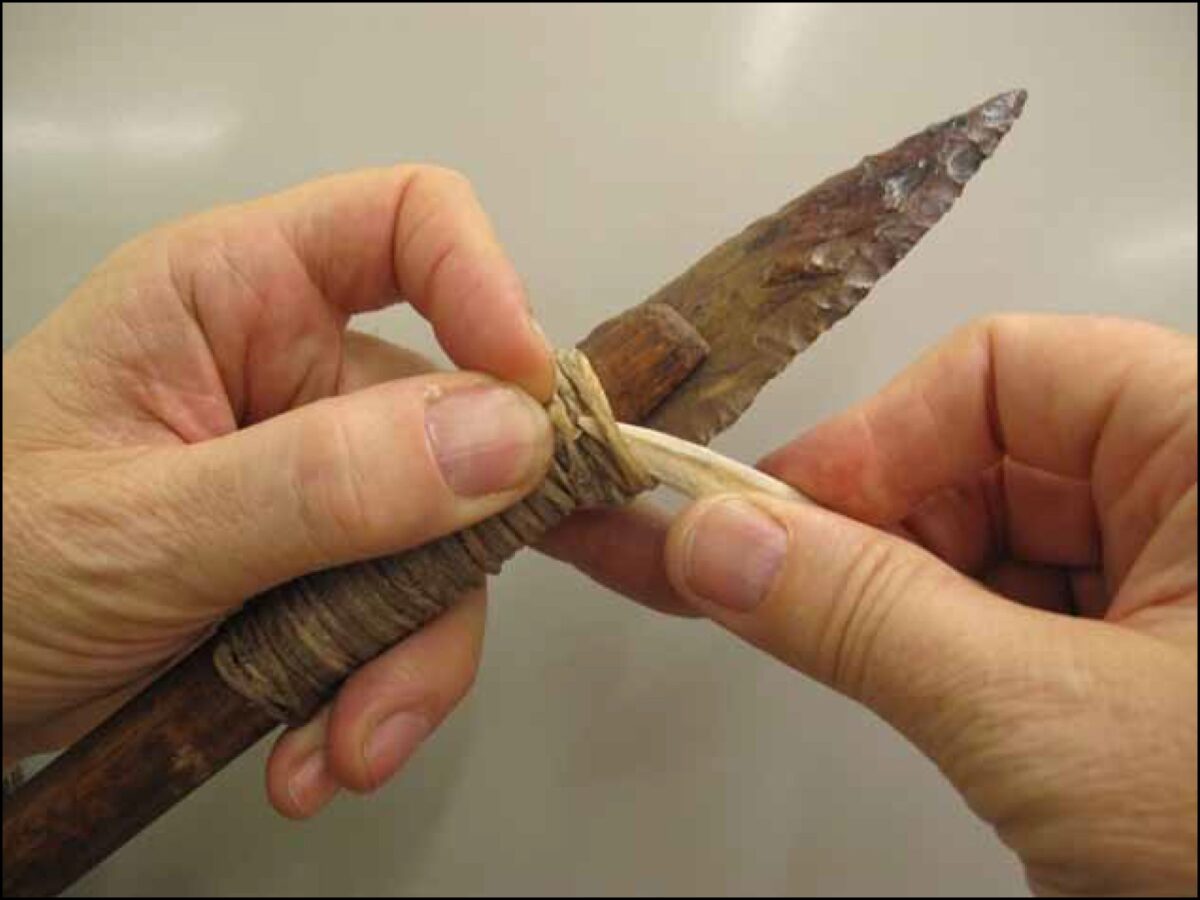Originally published in The Midden, 44(3/4).
Ulna Bone Tools: Identifying Their Function
By Grant Keddie. 2012.
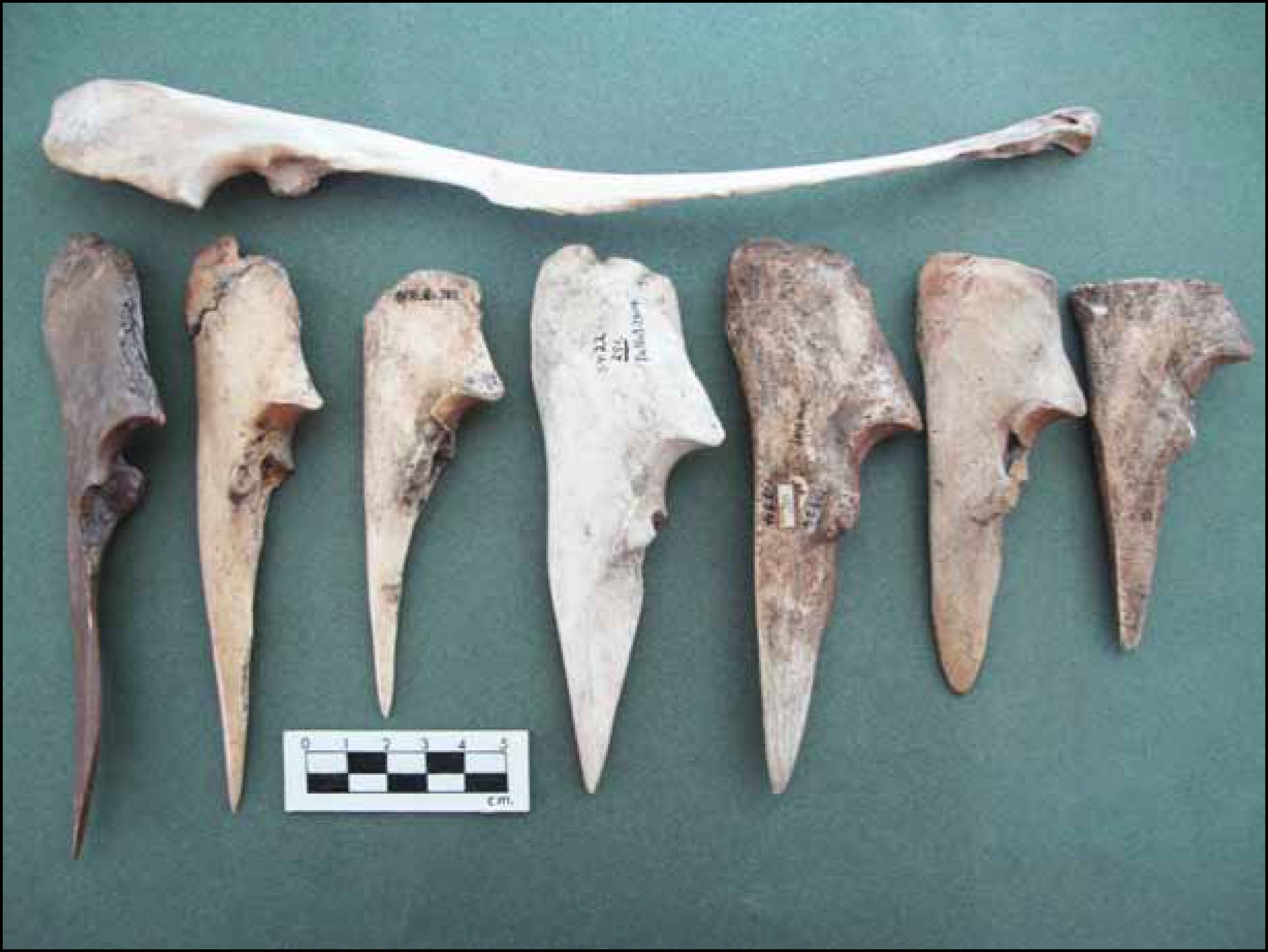
Ulna tools have several main uses that are often not recognized in the archaeological literature. Based on my own experimental uses and an examination of the ethnographic literature, we can describe at least four different common uses of ulna tools.
Ulna bones, which are the lower limb bones in animals, have a naturally shaped end that functions as a handle with little or no modification needed, and the pointed end is easy to shape into a functioning tool. The working ends of these tools need to be different to fit the intended function. Non-ulna bones with similar ends may, of course, have similar functions.
One type of ulna tool has a point that is sharp, more rounded, longer tapering and thinner. This tool is what is defined in western tradition as an awl or pricker used to poke small holes in things. Coiled baskets from the Interior of the province require the poking of holes, but this does not apply to most woven material on the coast. This tool would mostly be used for piercing holes in the preparation and making of fur and leather clothing (see the three ulnas on the left of Figure 1).
In contrast to the sharp awl is a fibre pressing tool that is not required for poking holes (see four ulnas on right side of Figure 1). It is similar, but has a thicker, duller working end that would have been used for two primary purposes. The first is to manipulate plant fibres used in making baskets and mats. It can push fibres into place without damaging them—as would more likely happen with a sharp point. The second is tying animal sinew, gut and rawhide, such as in the delicate art of tying on spear points. When a short point is pushed under a rawhide cord on its flatter side and then twisted sideways onto its thinner side, a space is opened to allow another cord to be pulled under it where it is held in place (Figure 2). In these tools, the thinning edge near the tip is often ground to create a flatter and therefore a less sharp point. The duller points generally have less of a taper at their thicker tips (Figure 3).
A third type of ulna tool has a thin flat end for splitting cedar bark into different layers, as well as for splitting roots (Figure 4). I am calling these bark splitting tools (not to be confused with the much larger bark stripping tools for leveraging bark off of trees).
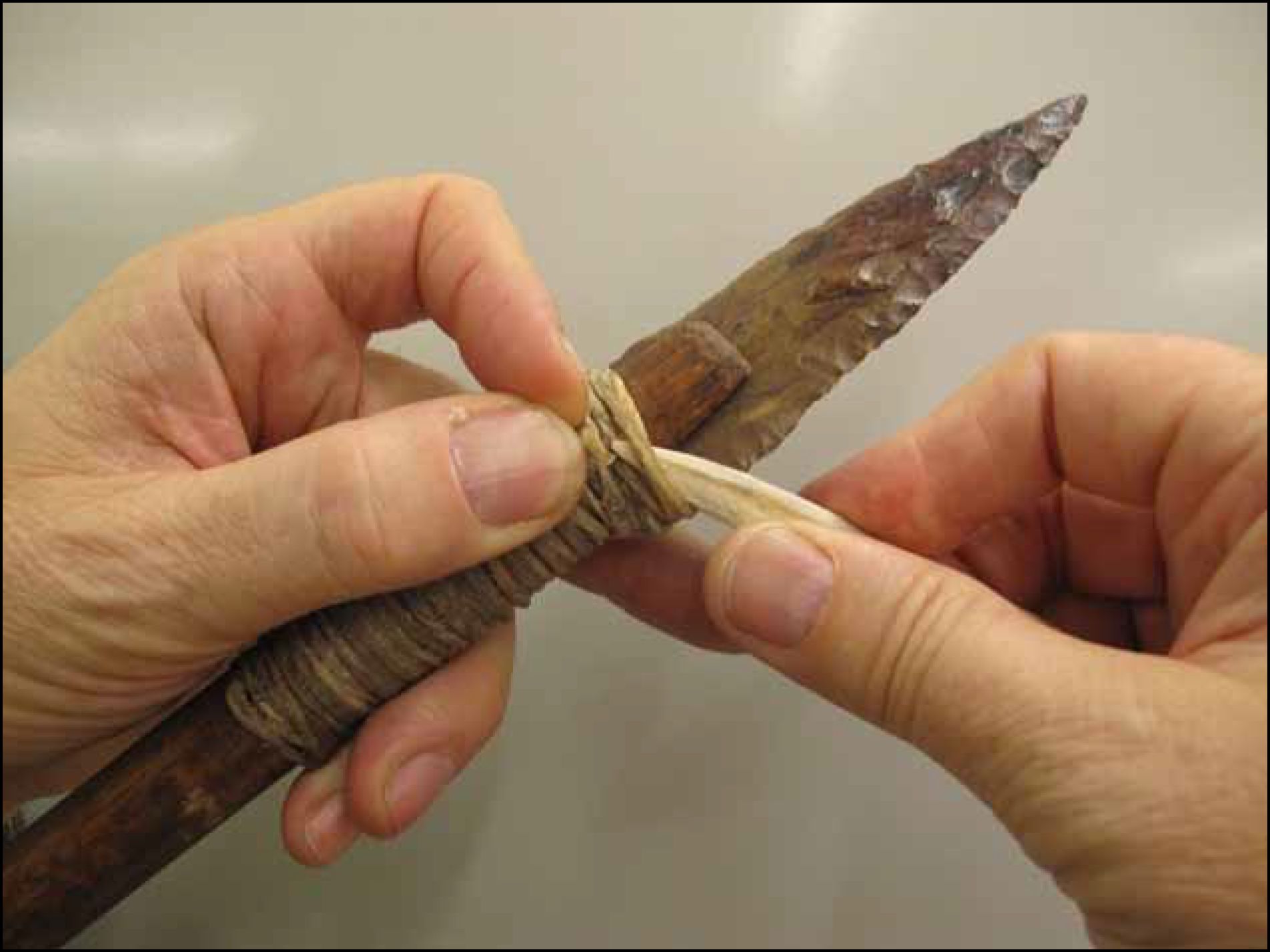
A fourth type of ulna tool is a knife for cutting or splitting small fish such as herring. In some cases it also served as a gutting tool. It generally has a short point that is flat-to-rounded near its tip. The lower edge is often sharpened. Its design allows it to cut into fish and survive the strong lateral pressure that is involved in the cutting and gutting process. Sharp, long, tapering, pointed bones cannot take much lateral pressure without breaking.
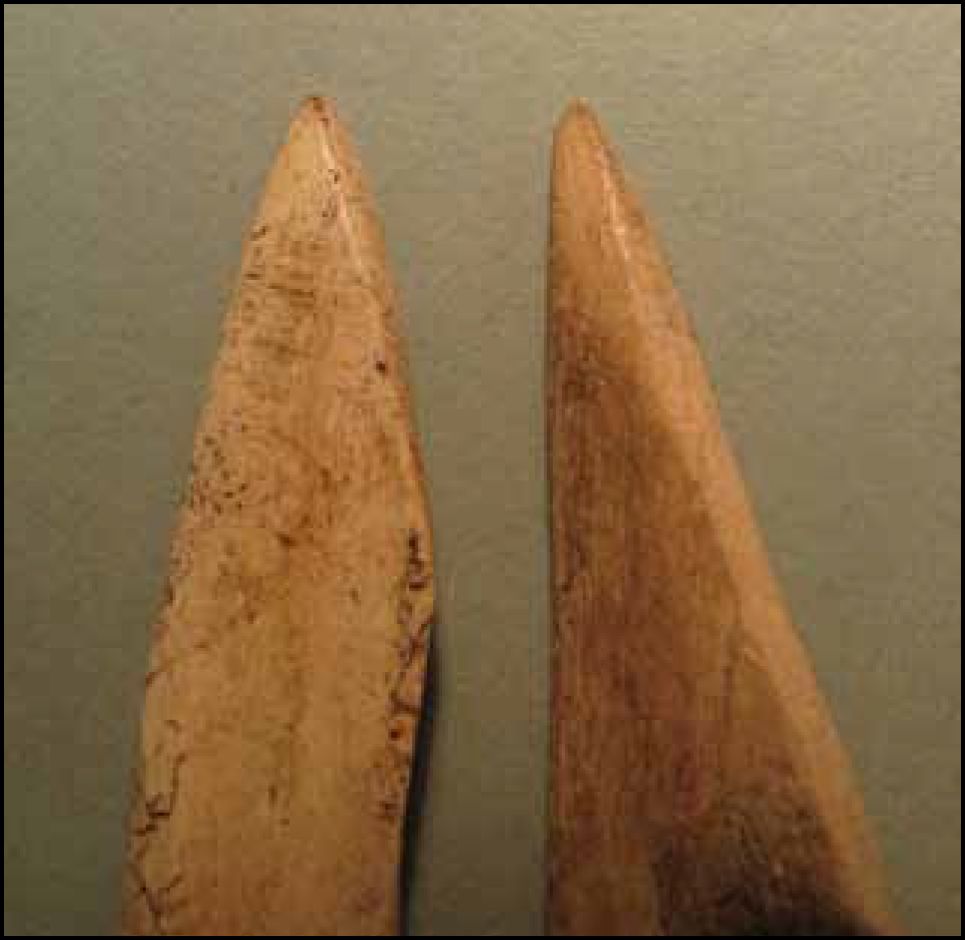
The Ethnographic Record on Ulna tools
What is the evidence from the written ethnographies and the ethnographic collection to support these uses? Ethnographic collections sometimes have tools whose use was observed by the collector, or provided by First Nation consultants, or both. However, there are also examples of ulna tools collected by ethnologists, that were both in recent use and found in archaeological sites, that exhibit recorded functions that were only a guess on the part of the cataloger. In the Ethnology collection of the RBCM there are only three ulna tools that have been assigned a functional use by an ethnologist.
The Ethnographic Artifacts
Artifact #9992 is a 170mm long deer ulna tool collected by Charles Newcombe in 1912 (Figure 5). In his Manuscript (Mss1077, Vol. 58, Folder 23) Newcombe refers to this as an “Awl or pricker of bone,” and gives the local name of “Kwetani.” The original catalogue says: “Nootka 1912,” and “awl-bone mat maker’s.” Although this was an ethnographic artifact, it was catalogued into the archaeology collection in 1974, with the Borden number DjSp-Y (the “Y” indicates the artifact is from the general area around Nootka Sound).
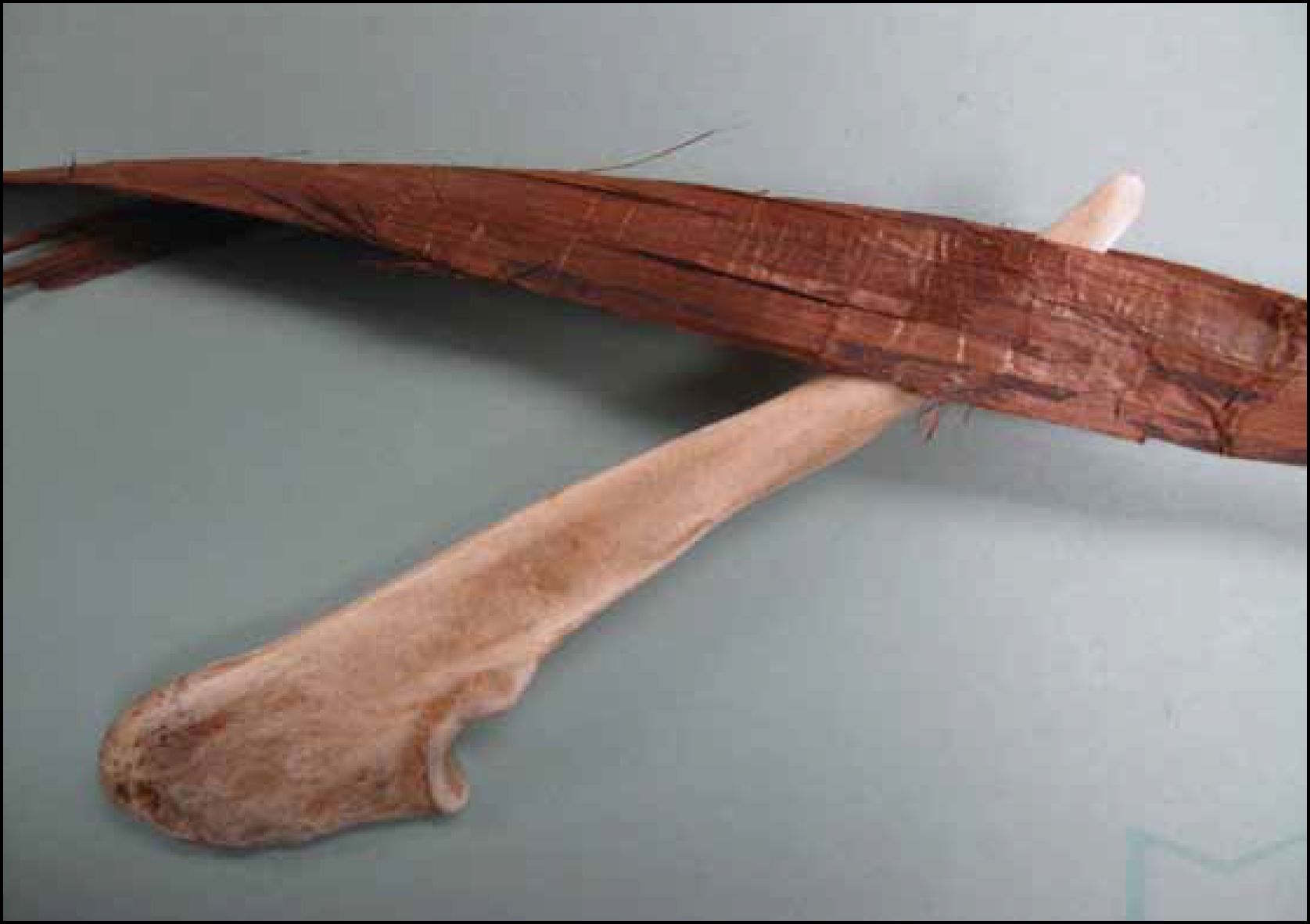
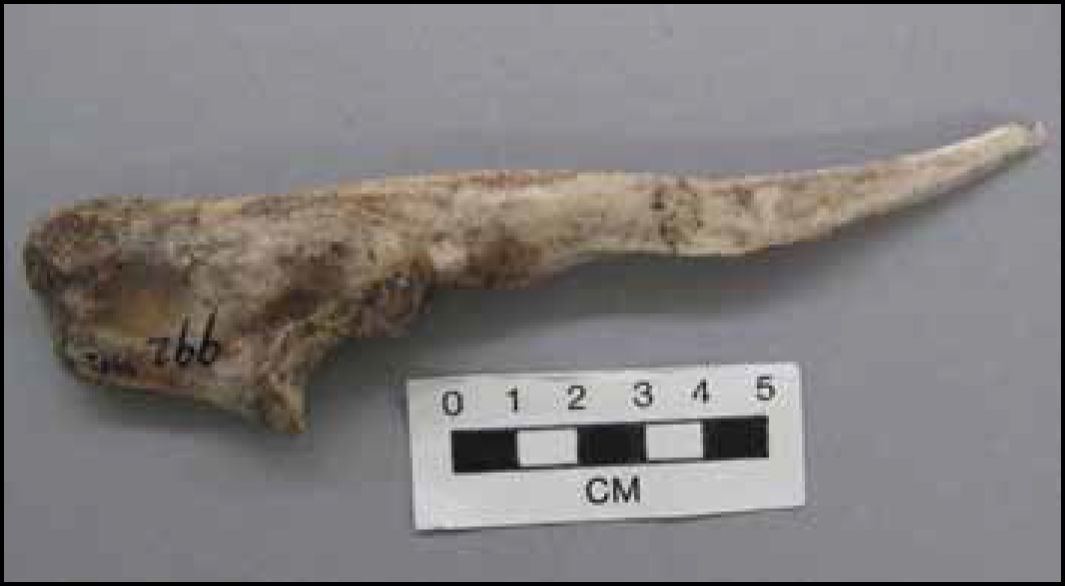
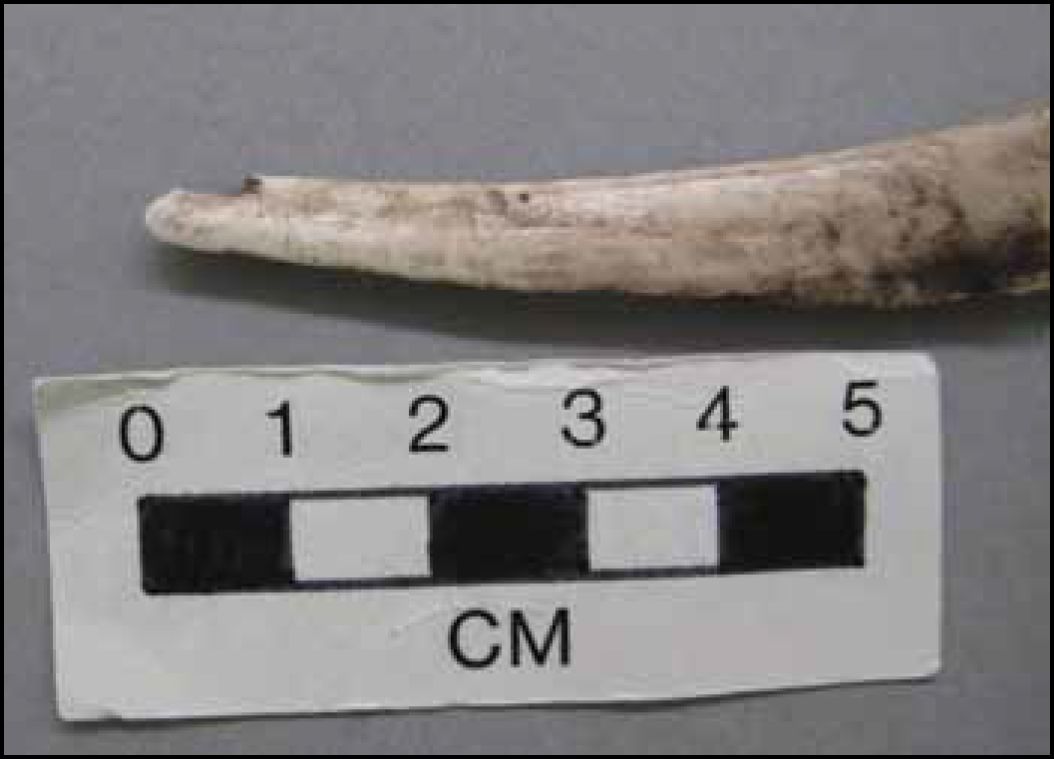
The tool shows evidence of distinct steel file marks. The distal end is intentionally flattened and partially rounded by filing the thinner outer edges (Figure 6). In making mats, one does not poke holes, but a tool is used to push the cross fibres into place to tighten up the weave. Although it is said that it is a mat makers’ tool, it does not specify the nature of its use. I would suggest that this tool was used to split the finer sections of cedar that are used in making the fibre the right size for making mats. I call this a cedar bark splitting tool.
Artifact #14230 (Figure 7) is a 139mm long ulna tool that has the handle end wrapped in a small piece of thin European manufactured cloth which is smeared in dried fish slime and scales. The collection was purchased by ethnologist Peter Mcnair in 1973, from the A. E. Caldwell, along with a collection of other ethnographic material, mostly from the central west coast of Vancouver Island.
The artifact was most likely collected by Caldwell when he lived in Ahousat from 1934-39, or in Alberni from 1944- 1960—although he did live briefly in Kitamaat from July 1939 to March 1940. A DNA analysis of the scales may help pin-point the source of the fish.
The tool gently tapers to a flat but rounded-off distal tip (Figure 8). The bottom of the distal end has been beveled to a thin cutting edge. The upper distal end is more rounded-off. A small 6mm notch area centred 11mm from the distal end appears to have been intentionally made—possibly for better gutting ac-tion? Similar notching can be found on archaeological specimens from the West Coast of Vancouver Island. I would call this a fish splitting ulna tool.
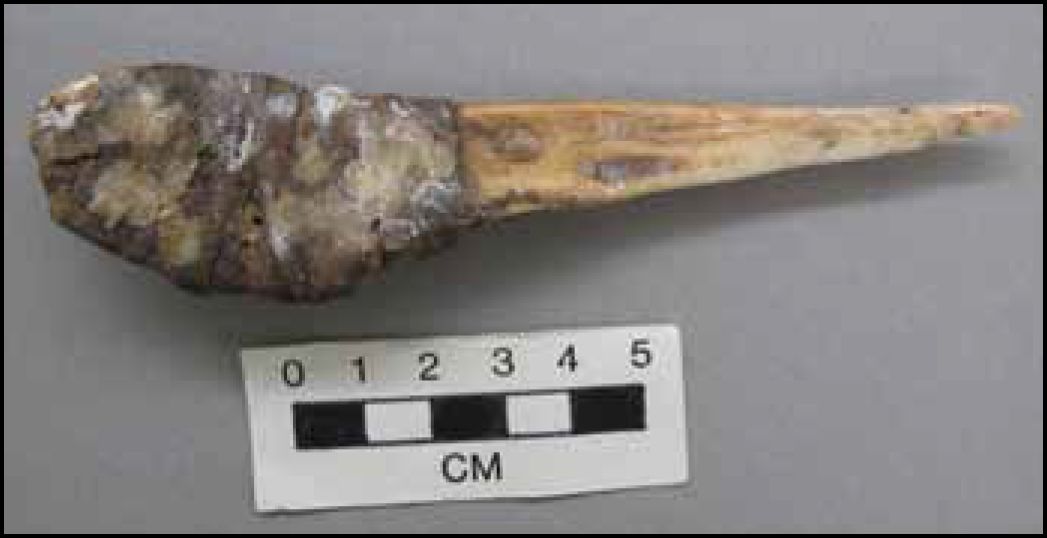
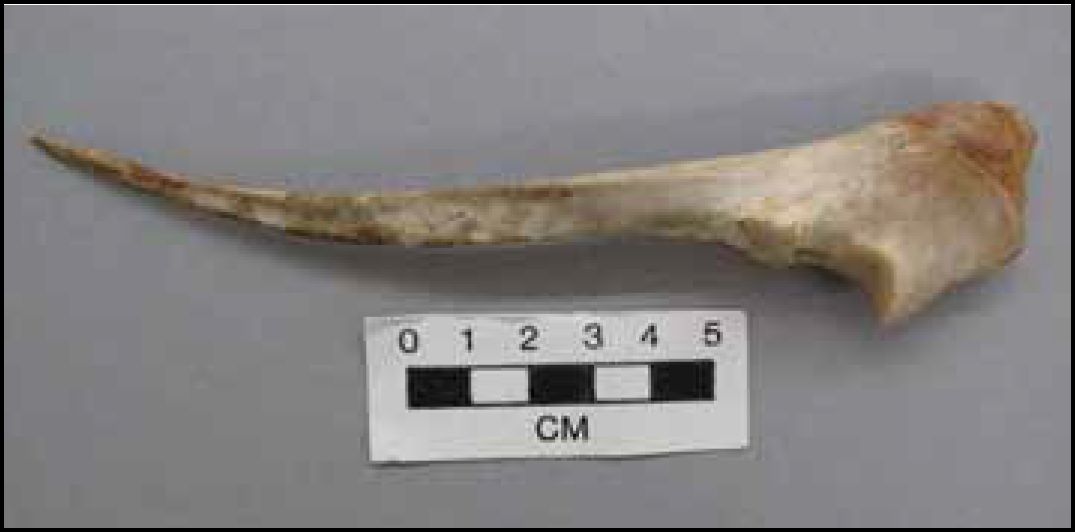

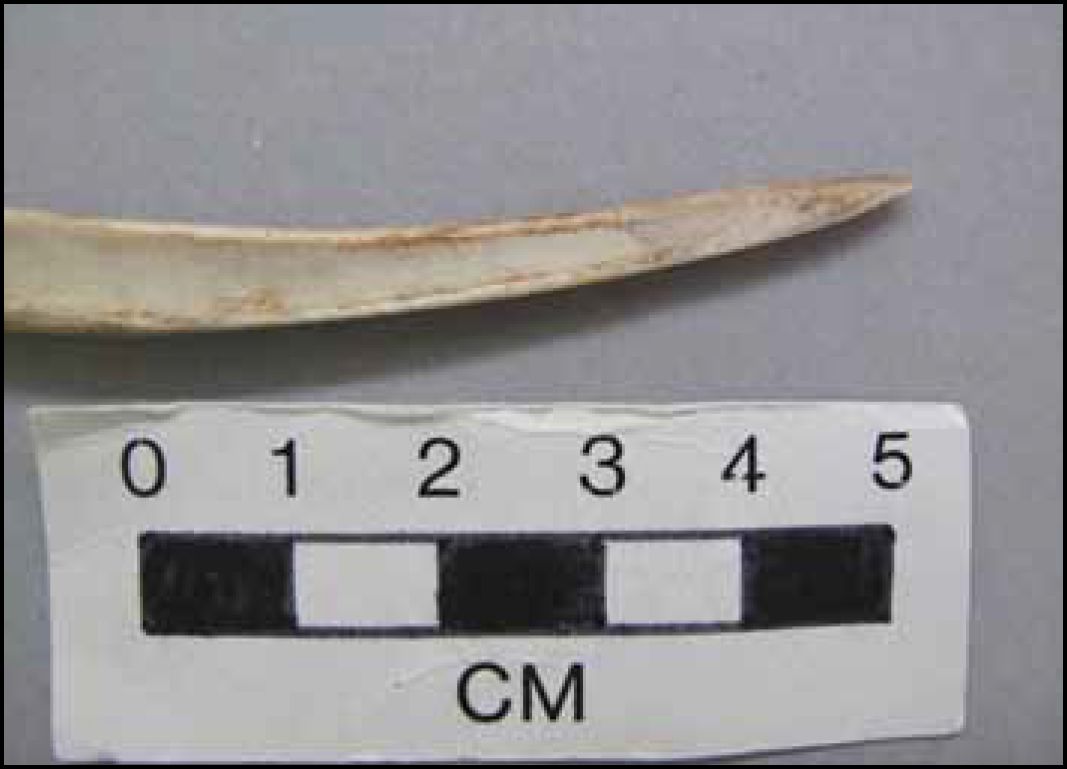
Artifact # 1251 (Figure 9 & 10) has contradictory information. The original catalogues indicate it is a “Kwakiutl Herring Knife” purchased at Nawhitti, by Charles Newcombe in 1900, and identified as the ulna of a Mountain goat.
Charles Newcombe’s notes, however, refer to this number as “mat maker’s knife,” “collected 1899.” It was acquired by the RBCM, Dec 14, 1900. The 170mm long artifact is a mountain goat ulna. Since mountain goats have not been on Vancouver Island for thousands of years, the owner must have brought it over or removed it from a carcass brought to the Island. The long, but not sharp point of the artifact would suggest that the latter stated use is the correct one and the tool was used for manipulating fibres in the making of mats. I would call this a fibre pressing ulna tool.
Ethnographic references
Cedar Bark Splitting Ulna Tool
Boas (1921:117) observed that, when processing cedar for making mats, a person uses the “cedar bark splitting-bone (the ulna of the foreleg of the deer), and grinds it well, so that it has a sharp point and also so that it is thin” and for “making narrow strips of bark” and for “stripping spruce roots.”
Boas later notes (1921:124) that that the bark-splitting ulna has “a flat end for it is sharpened on a sandstone.” A woman takes a folded bundle of stripped bark and splits it further. She then removes the second middle layer with the bone splitter. The outer layer was used for matting and course clover baskets and protecting new canoes. The middle layer was used for “ordinary mats and ordinary baskets,” and halibut fishing lines and anchor-lines for the halibut-fisher. The inner layer was for twilled mats, spoon baskets and the doubled twilled baskets used by “the daughter of the chiefs of the tribes” to keep their combs. Drucker (1951:95) observed that a deer ulna, or seal rib, usually served to the start the splits in preparing the inner bark layers.
Fibre Pressing Ulna Tool
An artifact similar to #9992 from the Puget Sound area is shown in a drawing in Ruby and Brown (1976:26) wrapped with cloth around its mid-section and extending toward the handle end. Eells (1985:169) describes this knife under Basket Working: “The only tools which I have seen in use are the knives for preparing the material, awls for sewing the water-tight baskets, and a bone implement for pressing the woven parts very firmly and closely together. […] It is not thick, and the edges dull. A cloth was wound around the handle to prevent it hurting the hand.” Eells describes the latter as 153mm long, 38mm at the handle, and tapering to a width of 6mm at the tip.
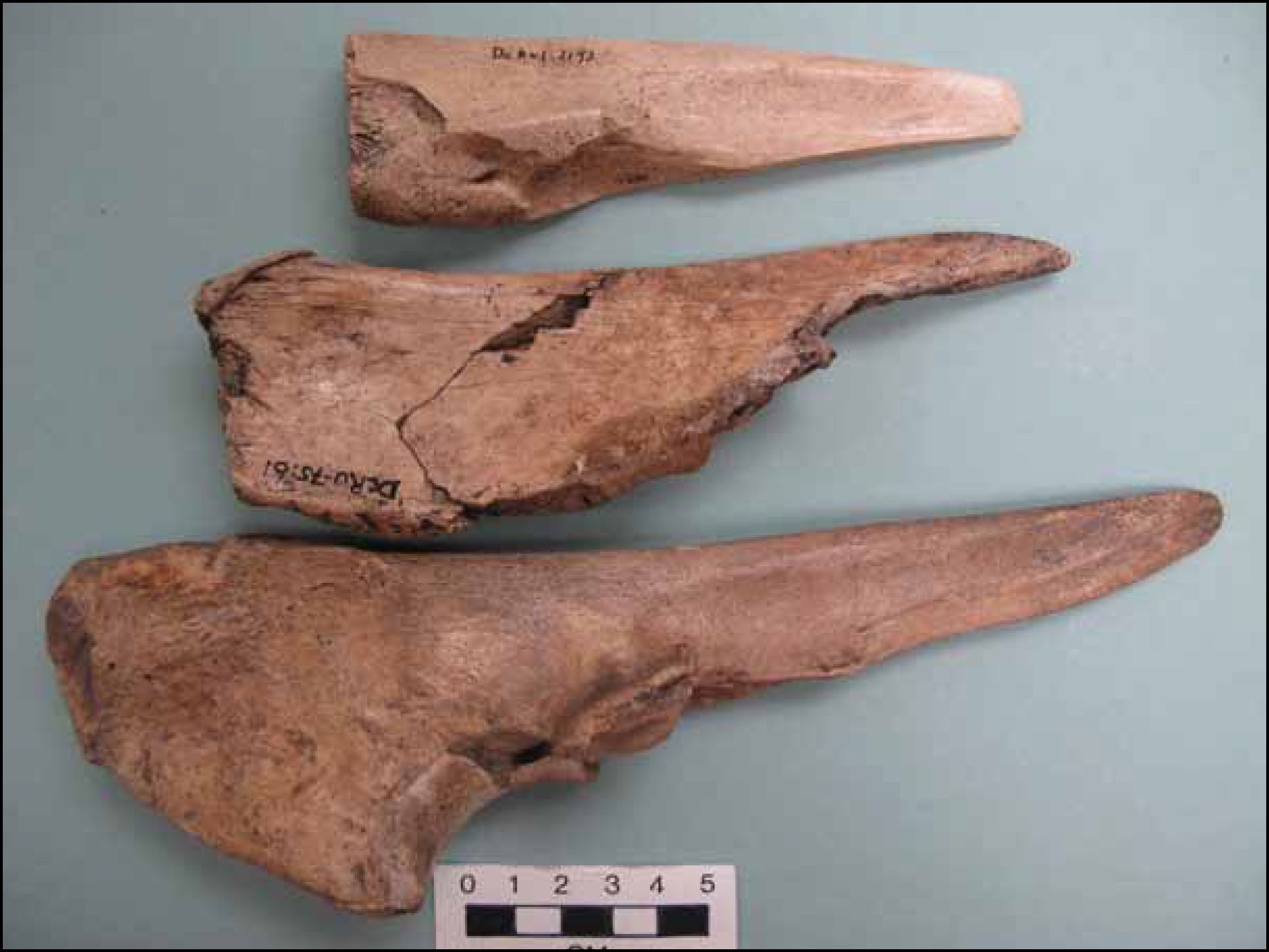
Fish Slitting Ulna Tool
Koppert’s (1930:23 & 29) Opitsit and Clayoquot consultants, whose memory would go back to the 1860s, noted that the ulna was used as a table knife as well as for cutting herring. The tool called “ha woi chek” was from the “foreleg of deer” suggesting an ulna (which only occurs in the foreleg) rather than a metapodial bone (which occurs in both front and back legs). His consultants also mentioned a Sea Otter cloak making awl (“Sot’h ta”) used to make holes for lacing. These are described as 102mm long with a 3mm wide “sharp point,” which had a loop of gut string through the end. The type of bone used in this awl cannot be determined.
Drucker (1951:91) observed that the women, of the northern and central Nuu-chan-nulth, used an “awl-like bone blade” for slitting herring in preparation for drying. They had a “prized variety of this knife” made of “a deer ulna ground to a long slim point.” It is interesting to note that this tool was used primarily for splitting the fish and not necessarily gutting it. Drucker (1951:65) observed that the larger herring were slit from head to tail with the bone tool, but not gutted. He explains that “apparently they do no feed as the time comes for spawning, and like smelt and similar fish have very little viscera then.”
Other Ulnas—Other Uses
Most ulna tools are made from deer ulnas, but elk ulnas are also used—in some cases to produce chisel-like tools (Figure 11).
Carnivore ulnas are much rarer, but include raccoon, dog, and at least one case of a lynx ulna from the mainland imported to Vancouver Island (Figure 12).
Summary
Ethnographic artifacts with older archaeological equivalents are often not common in museum collections. Where they do occur, it is important to take a critical look at the records to be sure that a more accurate comparison can be made with archaeological equivalents. Archaeologists often refer to ulna tools, with a variety of point shapes, as awls—implying a known function. It would be helpful to attempt to improve our classification system by being more specific about ulna tools where it seems warranted. I would propose that the ulna tools with steeper tapering and intentionally dulled points be referred to as fibre pressing ulna tools and the ones with flattened and thinned points be called bark splitting ulna tools. Fish gutting ulnas should be longer tapering but thicker with only the lower edge sharpened. These may be harder to separate out from the ulna bark splitters, but regional distinctions, such as those with notches near the end, may arise with more detailed descriptions.
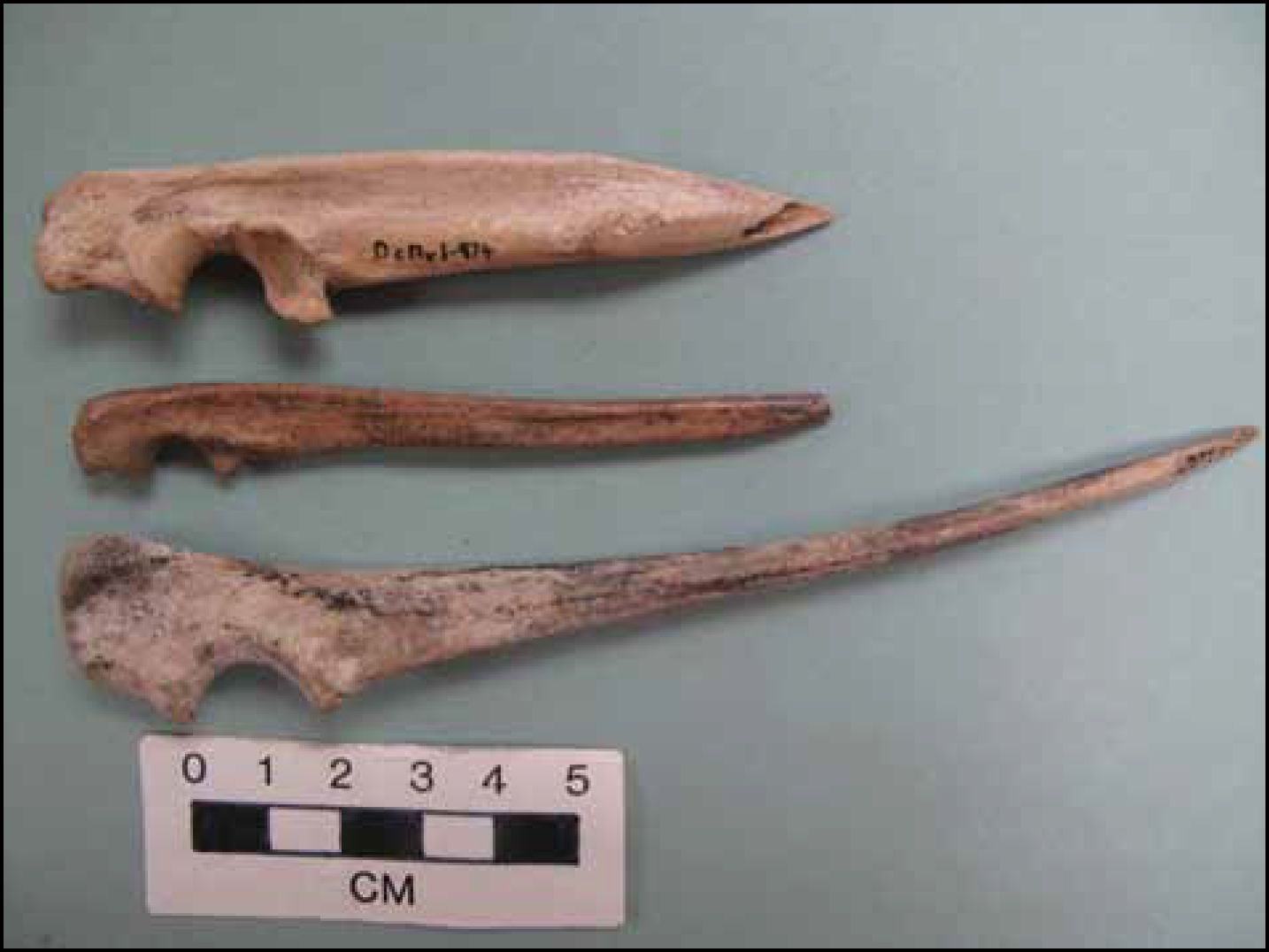
References
Boas, Franz. 1921. Ethnology of the Kwakuitl. (Based on information collected by George Hunt), 2 Pts. Pp. 43-1481. In: 35th Annual Report of the Bureau of American Ethnology for the Years 19131914. Washington.
Drucker, Phillip. 1951. The Northern and Central Nootkan Tribes. Smithsonian Institution Bureau of American Ethnology, Bulletin 144. United States Government Printing Office, Washington.
Eells, Myron. 1985. The Indians of Puget Sound: The Notebooks of Myron Eells. Edited by George P. Castile, University of Washington Press, Seattle, Washington.
Koppert, Vincent A. 1930. Contributions to Clayoquot Ethnology. Catholic University of America. Anthropological Series 1:1-130. Washington.
Ruby, Robert H. and John A. Brown. 1976. Myron Eells and the Puget Sound Indians. Superior Publishing Company, Seattle, Washington.
